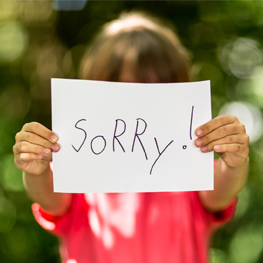
At first blush, teaching kids to apologize seems simple. You instruct them to say sorry to whomever they wronged and you move on. But did your child only say sorry to appease you? Does your child really understand what they did wrong? Teaching kids to apologize with sincerity helps them learn lessons in empathy, nurturing and forgiveness. And given the messiness of life, those moments requiring apologies tend to be plentiful for practice.
Establish house rules. From an early age, clarify behaviors that are okay and those that are not to help youngsters hone their sense of right from wrong and develop strong social skills.
“It’s really important to praise the behavior you want to see more of, like, ‘Thank you for asking before taking that toy from your brother,’” says Dr. Jane Sosland, child psychologist. “Then enforce consequences if they break the rules.”
And often that means an apology is necessary.
Role model. Consider this common scenario: Junior grabs a toy from the hands of another tot at a playdate. Embarrassed in front of the other parents, you jump in demanding that he give the toy back and apologize.
“By immediately scolding him in front of other people, that embarrasses and shames the child without giving him time to reflect about the situation,” says Dr. Stephanie Mihalas, child psychologist.
Instead, model an empathetic apology. Mihalas suggests the following formula:
Apology statement: “Johnny, I’m really sorry that got taken out of your hand.”
Feeling statement: “You must feel really bad because you were playing with it.”
Corrective response: “I’m going to give it back to you because I know that it shouldn’t have been taken away from you.”
“Eventually, what you hope happens is your child picks up implicitly based on how you behave with other people,” says Mihalas.
Practice skills. Rather than lecturing your tyke about what they did wrong, role play when you get home by asking your child questions like, “I know you really wanted to play with that new toy that Bobby had, but what could you have done differently that wouldn’t have made him cry?”
“By doing that, you are teaching him positive tactics and skills,” says Mihalas.
Show remorse for your mistakes. When you apologize to your children for mistakes you make (and who isn’t guilty of the occasional bad parenting moment?), you show them that no one is above culpability. In turn, they have the opportunity to express forgiveness.
Then work to correct your behavior.“The whole point about teaching kids to say sorry is so they can learn from their mistakes,” says Sosland. “If we are repeatedly saying sorry (for the same thing), we demonstrate that we are not learning.”
But only apologize if you are truly at fault. Instead of saying “I’m sorry” for a disappointment you had no control over, show understanding by saying something like: “I know. I’m sad that happened too.”
Cool off first. A hasty “I’m sorry” in the heat of anger is rarely meaningful. Give your child time to calm down in their room and set a time limit for an apology, says parent coach Laura Murphy, president of Real Families, Inc. For instance: “You are welcome to rejoin us once you apologize.”
Then, give your child age-appropriate choices for how they would like to apologize. “Would you like to apologize with a hug or with your words?” or, “Would you like to draw a picture or write a letter saying you are sorry?”
Reinforce words with nurturing, corrective action. As part of the apology, help your child find actionable ways to make amends.
For example, Murphy says: “‘If you are going to call your sister names, I want you to say three nice things to her.’ Or, ‘You hurt your brother. Let’s get him an ice pack to help him feel better.’”
“But I’m not sorry!” As every parent knows, there are two sides to every story and understanding what happened isn’t always obvious. Once emotions have simmered down, talk to your child and find out why they don’t feel like they should apologize.
“We really don’t want to insist they say sorry when they aren’t sorry,” says Sosland. “Maybe they are right not to feel sorry. Maybe they reacted in a situation where the other child is badgering them and making fun of them, and finally they couldn’t stand it any longer. It’s important to validate their feelings and not to try and convince them to feel differently. There are no right or wrong feelings.”
Problem-solve ways to handle the situation better in the future. And discuss if there is any part of the incident for which your child should be held accountable. For example, even if your child’s anger was justified, hitting their playmate wasn’t the right way to handle it. In this case, your child could say, “I’m sorry that I hit you.”
“It would solve most of the world’s problems if we took care of what we are responsible for instead of rubbing each others’noses in what we think the other person should be responsible for,” says Murphy.
Teaching forgiveness. As kids learn to say sorry, they also learn forgiveness.
“Apologizing is humbling and that’s part of what builds character is being able to humble yourself when you’ve been wrong,” says Murphy. “On the flip side of that is humbling yourself to forgive somebody when you’ve been wronged.”
The famous English poet Alexander Pope once wrote, “To err is human; to forgive, divine.” We all make mistakes. By learning to give and accept apologies with empathy and grace, we develop integrity in ourselves and trust in each other. In return, we are rewarded with friendships that last a lifetime.
Freelance journalist Christa and her husband are the parents of two boys. Christa’s latest book is Happy, Healthy & Hyperconnected: Raise a Thoughtful Communicator in a Digital World.
Calgary’s Child Magazine © 2024 Calgary’s Child